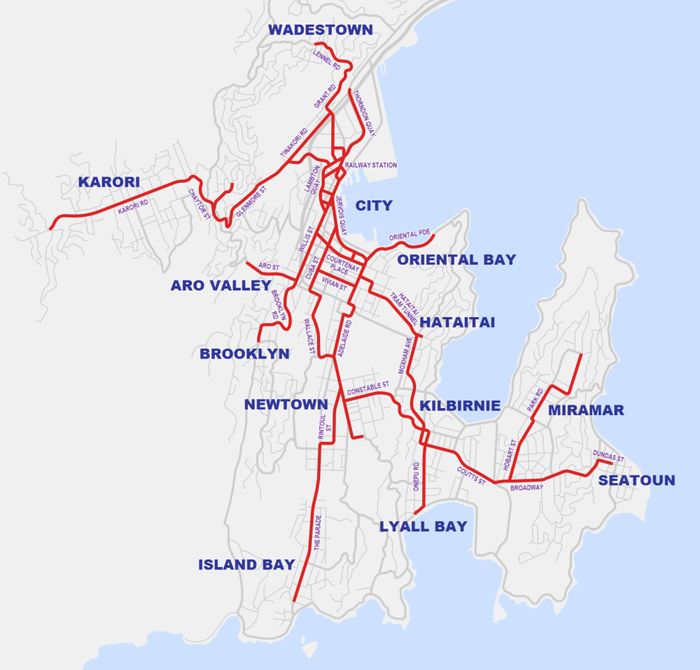Wellington tramway system

The Wellington tramway system (1878–1964) operated in Wellington, the capital of New Zealand. The tramways were originally owned by a private company, but were purchased by the city and formed a major part of the city's transport system.
Trams
Initially in 1878, Wellington's trams were steam-powered, with an engine drawing a separate carriage. The engines were widely deemed unsatisfactory, however — they created a great deal of soot, were heavy (increasing track maintenance costs), and often frightened horses. By 1882, a combination of public pressure and financial concerns caused the engines to be replaced by horses. In 1902, after the tramways came into public ownership, it was decided to electrify the system, and the first electric tram ran in 1904. Trams operated singly, and were mostly single-deck but some double-deck.
History
The first tram line in Wellington opened on 24 August 1878. The line was 4.5 km in length, and ran between the north end of Lambton Quay and a point just south of the Basin Reserve.
After 1900, when the tramway was bought by the city authorities and electrified, a major extension of the network took place, with lines to Aro Street, Oriental Bay, and Tinakori Road in operation in 1904. The following year, a line was constructed through Newtown and Berhampore to Island Bay, and the year after, from the Te Aro line to Brooklyn. In 1907, a dedicated tram tunnel to Hataitai was completed, allowing services to reach Kilbirnie, Miramar, and Seatoun. The Tinakori Road line was extended westward towards Karori, reaching Karori Cemetery.
Construction of new track then slowed, but did not stop. In 1909 a line was built from Kilbirnie to Lyall Bay and then another from Tinakori Road to Wadestown. By this time, the Karori line had been extended to Karori Park. In 1915, a line was built to connect Newtown with Kilbirnie, via Constable Street and Crawford Road. Finally, in 1929, the last new line was completed, a branch of the Karori line through a tunnel to Northland.
In 1924, a case went to the Court of Appeal of New Zealand challenging the use of eminent domain to secure right-of-ways for tracks. In Boyd v Mayor of Wellington, the court found that, although the government forced the sale of land improperly, it had acted in good faith so the sale was not reversed.
Wellington's more northerly suburbs, such as Johnsonville and Tawa, were not served by the tram network, as they were (and are) served by the Wellington railway system. The Wellington Cable Car, another part of Wellington's transport network, is sometimes described as a tram, but is not generally considered so. It was opened in 1902, and is still in operation.
Wellington's electric tramways had the unusual gauge of 4 ft (1,219 mm), a narrow gauge. The steam and horse trams were 3 ft 6 in (1,067 mm) gauge, the same as New Zealand's national railway gauge.
Map
The map below shows the Wellington tramway network at its greatest extent, superimposed on a map of the city as it is today.

Closure
In the late 1940s and early 1950s it was decided to replace the trams with buses and trolleybuses, which were seen as more advanced and better suited to the city's needs. The topography of Wellington played a part in this decision - the city's streets are often steep, winding, and narrow, making the greater manoeuvrability of buses a significant asset. The principle of electric transport was retained — many of the tram routes are now served by trolleybuses, see Trolleybuses in Wellington.
The first major line closure came in 1949, when Wadestown closed. The following year the Oriental Bay line closed. In 1954, the Karori line (including the Northland branch) closed. In 1957 services to Aro Street and Brooklyn ended, and the construction of Wellington International Airport destroyed the route to Miramar and Seatoun. All services to the eastern suburbs had ceased by 1962, with Lyall Bay closing in 1960, Constable St/Crawford Rd in 1961, and Hataitai in 1962. (The Hataitai tram tunnel is still in use by buses.) In 1963, the service to Island Bay was withdrawn, leaving mainly inner-city routes. On 2 May 1964 the remaining portion was closed, with a parade from Thorndon to Newtown.
Some of Wellington's old trams have been preserved, and are now in operation at the Wellington Tramway Museum at Paekakariki. Occasionally, it has been suggested that trams should return to Wellington, either in a modern form or as a historical display — in the 1990s, a heritage line was proposed for the city's waterfront, and more recently, a light rail line has been suggested through the city centre. As yet, however, there are no firm plans for any restoration.
Present
Trams still operate today, but only in the Wellington Tramway Museum at Queen Elizabeth Park in Paekakariki.
External links
- Wellington City Libraries tram page
- Wellington Tramway Museum
- Wellington Electric Tram 1904 on 1985 45c stanp
- View Photos (405) via Archives Search: search for 'tram', tick images only
- Photo of horse tram on The Quay 1900
- Photo of woman tram conductor 1943
- Photo of woman tramway employees repairing track 1944
- Article about opening of Lyall Bay line